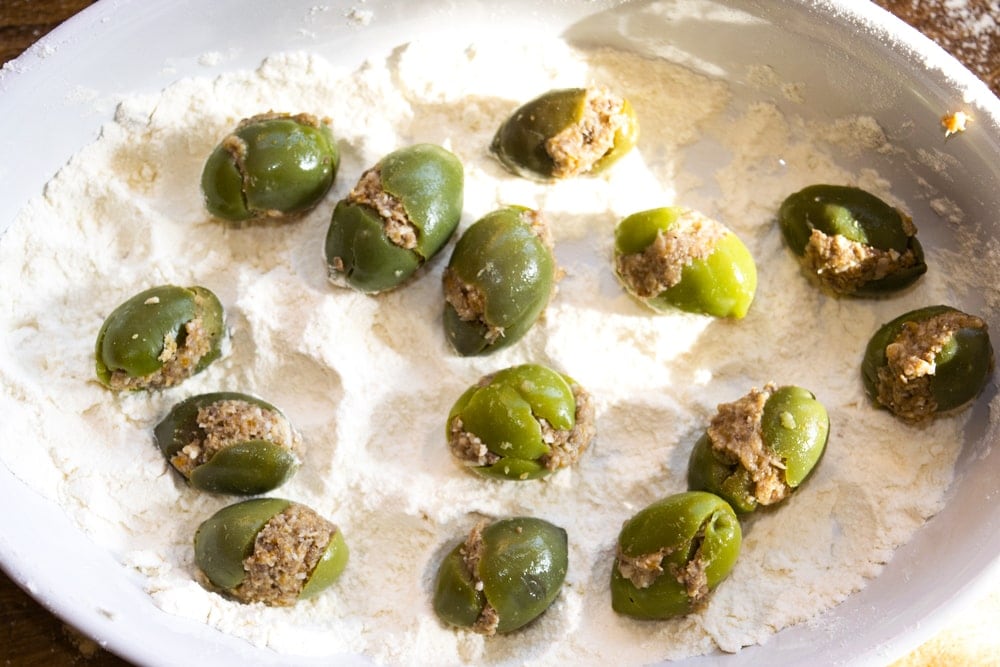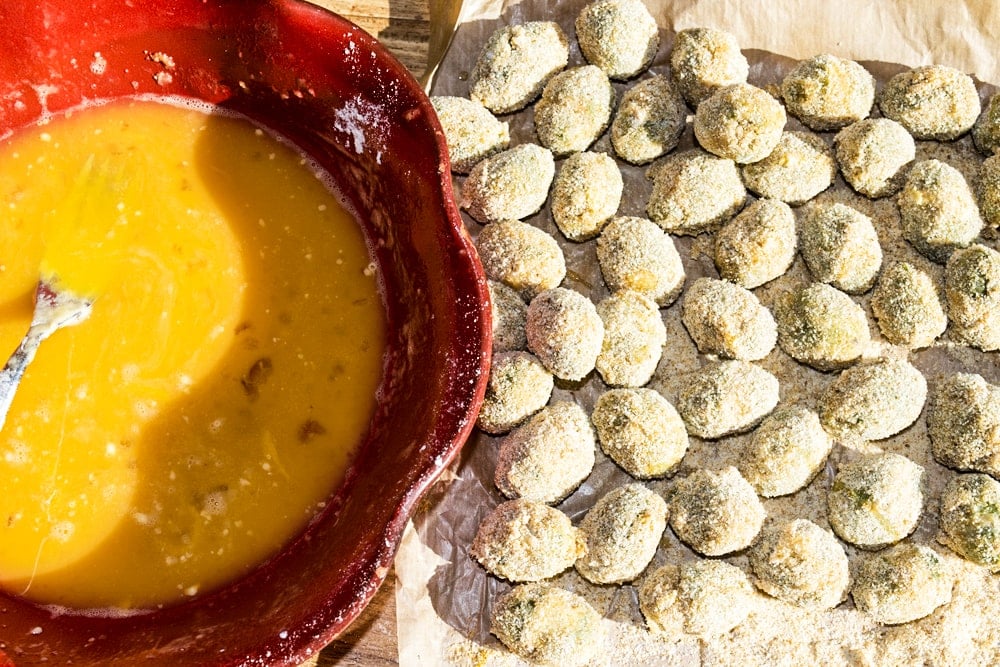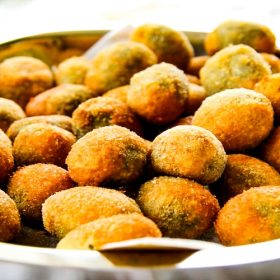A crisp golden sphere, whose core is made of a tasty olive covered with a shell of meat and scents.
The olive ascolana, a typical street-food of the Marche region, hides a truly intriguing story. Let’s find out together the truly fascinating origin of the Ascolane Olive Recipe.
The history of Ascoli Olives begins in ancient Rome, where the olives in brine represented, thanks to their nutritional content, a daily staple of the Roman legionaries diet. Olives provided many benefits for the Roman army, they provided excellent nutrition and in addition, their shape and portability made them the ideal food for long journeys.
The Latin name colymbades, which derives from the Greek κολυμβάω (colymbáo, “swim”) refers to the preservation method used at the time. This process involved the olives being subjected to different washings and subsequently preserved in brine.
In Roman times there were many authors who extolled the goodness of this dish, including Cato, Varro, Martial and Petronio who, in his famous novel Satyricon, placed them on the famous tables of Trimalcione.
The admirers of the Marche olives do not stop here: during the sixteenth century, Pope Sixtus V also recognized their delicacy in a letter sent to the Elders of Ascoli.
Garibaldi, after having tasted and appreciated them in Ascoli on January 25th, 1849, decided to grow some olive trees in Caprera, so as to be able to reproduce the Recipe of the Ascolane Olives for himself. As you can see olives have excited and delighted food lovers for many many years.
For the history of Ascolane Olives as we know them today, we must move forward a few centuries, to the year 1800. It is widely believed that during this period chefs in the service of noble families of Ascoli invented the practice of stuffing the olives.
Apparently, as with all good recipes the idea of a stuffing of meat was introduced because the cooks needed to use the considerable quantities and varieties of meats that they had available. Because there were no tools for food storage, the cooks learned to reuse what they had in different recipes, in order to keep from wasting food.

preparing stuffed ascolana olives at home
Peel the olives, strictly by hand, with a chat and a smile. Armed with patience and a knife, it is really very simple, because the olive has a small pit that is easily detachable from the pulp. The cut must be spiral, and the olives must then be left to soak in cold water.
“… Eppuó ce mitte
Carne fresca, parte uguale,
Pulle, manze e lu maiale,
Magra, scedda e fatt’a piezze… ”
The nonne (grandmothers) would sing this nursery rhyme as they prepared them. It is a sort of lullaby to help remember the steps and the ingredients: three types of meat cut into pieces and browned with the lard of minced ham or olive oil. Remove the meat from the pan and let it cool, then reduce the cooking base with some wine over a gentle fire.
Finely mince the meat, inserting in the following order: the aromas, the cooking base, the tomato sauce, an egg and a yolk, and grated Parmigiano-Reggiano cheese, and then pound the mixture in a mortar. Stuff the olives, returning them to their original elongated oval shape, then roll them in breadcrumbs. Before cooking, let them rest for a while, so that the ingredients have time to blend and harden. Then fry in olive oil.

In 2005 the Ascolane Olives were recognized as a DOP (Denominazione di Origine Protetta, or literally “Protected Designation of Origin”) product.
This label is applied to foods whose particular qualities and characteristics depend exclusively on the territory in which they are produced.
The geographical environment includes both natural factors (climate, environmental characteristics), and human factors (production techniques handed down over time, craftsmanship, know-how) that, when combined, make it impossible to obtain an inimitable product outside a specific area.
Furthermore, in order for a product to be DOP, the steps of production, processing and processing must take place in a defined geographical area.
The municipalities that are part of the Consortium for the protection of Oliva Ascolana total 61 between the provinces of Ascoli Piceno and Fermo, and 27 for the province of Teramo.
Land and sea, medieval fortresses and castles, soft hills and unexpected views, this land, with its diversity of landscape and territory, is the mother of Olivo Ascolano.
Viewed from the sky looks like a lush tree with thick foliage and gives us the Olea Europaea sativa, or “Ascolana Tenera”, whose harvest takes place between September 10 and October 20. Then they are preserved according to a very specific process:
– Deamarization (Literally “debittering”) by immersion in a sodium hydrate solution for 8-12 hours
– Olive washing
– Fermentation and storage in brine for a minimum of 10 months
As you can see, the process is not a quick one, and takes considerable time, effort and attention to detail. It is truly a labor of love, steeped in tradition, secrecy and a little mystery.
Although there are many recipes that every Marche family jealously guards, the stuffed olive with the designation DOP “Oliva Ascolana del Piceno” must be produced following traditional methods and using these ingredients:
– 40-70% beef
– 30-50% pork
– Max 10% chicken or turkey
– 2-4 eggs for each kilo of dough
– 100 g of grated mature Parmigiano Reggiano cheese
– Extra virgin olive oil or butter as required for cooking
– Finely diced carrot, onion and celery
– Dry white wine for cooking
– Nutmeg, cloves, lemon peel and salt to taste
– Eggs, wheat flour and breadcrumbs for breading

This recipe does come with a warning. Once tasted most people fall in love with the delicious taste, and will want to experience it on a regular basis, so be aware of this before exposing your taste buds to this Italian masterpiece!!
I tried these for the very first time at a wedding last night. I thought they were fantastic. I look forward to trying to make them at home.
Grazie mille!! Glad they turned out great!